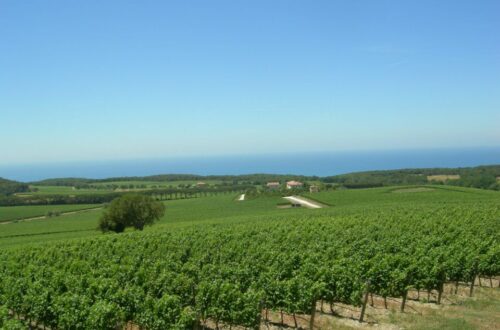Oltrepò Pavese DOC is a wine region in Lombardy, Italy, just south of the Po River. Known for its Pinot Nero (Italy’s third-largest planted area) and Metodo Classico sparkling wines, it produces red, white, rosé, and sparkling styles across rolling hills and medieval villages. With its proximity to Milan, rich culinary traditions, and growing reputation, Oltrepò Pavese is a must-visit for wine lovers.
Table of Contents
What is Oltrepò Pavese DOC?
Often called the “Tuscany of the North”, Oltrepò Pavese DOC encompasses a variety of wine styles—from structured Pinot Nero reds to elegant sparkling Metodo Classico. This diversity, combined with affordable prices, has made it a rising star in Italian wine.
History and Origins
Viticulture here dates back to Roman times, but Oltrepò Pavese’s modern wine identity took shape in the 19th century when Pinot Nero was introduced. The DOC was officially recognized in 1970, and today the region is gaining global recognition for sparkling wines that rival Franciacorta.
Where It’s Made: Geography & Terroir
Nestled in southern Lombardy, the region spans 13,500 hectares across 42 communes. The rolling hills, calcareous clay soils, and microclimate influenced by the Ligurian Sea create ideal conditions for both still and sparkling wine. Its location, just an hour from Milan, makes it perfect for weekend wine tourism.
The Grape (or Blend)
While Pinot Nero is the star (used for both red and sparkling), other key grapes include:
- Croatina (Bonarda) – Deep, fruity reds
- Barbera – Juicy acidity and versatility
- Riesling Italico – Crisp whites
- Pinot Grigio & Chardonnay – Sparkling and still wines
Winemaking & DOC Regulations
- Metodo Classico Sparkling – Minimum 15 months on lees
- Pinot Nero Red – Aged for at least 12 months
- Varietal Wines – Must contain a minimum 85% of the named grape
The Oltrepò Pavese Metodo Classico DOCG applies to sparkling wines with stricter rules and longer aging.
Key Facts at a Glance
- Location: Lombardy, south of the Po River
- DOC Established: 1970
- Primary Grapes: Pinot Nero, Croatina, Barbera
- Wine Styles: Red, white, rosé, sparkling
- Vineyard Area: ~13,500 hectares
- Producers: 170+
- Average Price: €6–€25
Tasting Notes
Pinot Nero (Red) – Cherry, violet, earthy spice, silky tannins
Metodo Classico – Brioche, citrus zest, fine mousse, mineral finish
Bonarda (Croatina) – Blackberry jam, plum, peppery finish
Serving & Pairing
- Pinot Nero: Serve at 16°C with roast duck or mushroom risotto
- Metodo Classico: Serve at 8°C with seafood antipasti or fried sage leaves
- Bonarda: Serve at 14°C with salumi, aged cheeses, or rich pasta dishes
Top 10 Producers to Know (New Section)
- La Versa – Historic sparkling wine house
- Monsupello – Award-winning Metodo Classico
- Frecciarossa – Iconic Pinot Nero reds
- Castello di Luzzano – Historic estate with panoramic views
- Tenuta Mazzolino – Elegant Burgundian-style Pinot Nero
- Torti L’Eleganza del Vino – Known for approachable Pinot Nero and Bonarda
- Calatroni – Organic sparkling and still wines
- Cecilia Beretta – Boutique producer with premium selections
- Bisi – Known for varietal purity
- Torre degli Alberi – High-altitude vineyards and small-lot wines
Wine Tourism Guide: 3-Day Itinerary (New Section)
Day 1 – Arrive in Pavia, visit La Versa & Monsupello, dinner in Casteggio
Day 2 – Morning hike in the hills, lunch in Santa Maria della Versa, tasting at Frecciarossa & Calatroni
Day 3 – Visit Certosa di Pavia monastery, final tasting at Tenuta Mazzolino before heading to Milan
Best Time to Visit: September–October for harvest or May–June for festivals
Price & Value Guide (New Section)
- Bonarda DOC – €6–€10 (great value everyday wine)
- Pinot Nero DOC – €10–€18 (affordable compared to Burgundy)
- Metodo Classico DOCG – €15–€25 (excellent Champagne alternative)
FAQ on Oltrepò Pavese DOC
What wines is Oltrepò Pavese famous for? Pinot Nero and Metodo Classico sparkling wines.
How much do they cost? Most bottles range from €6–€25.
Where can I visit wineries? Santa Maria della Versa is the main hub, with easy access from Milan.
What makes the Pinot Nero special? The region’s terroir gives wines both elegance and structure.
Fun Facts & Cultural Notes
- Called “Tuscany of the North” for its beauty and vineyards
- Produces 70% of Lombardy’s wine output
- Has Italy’s oldest sparkling wine competition


